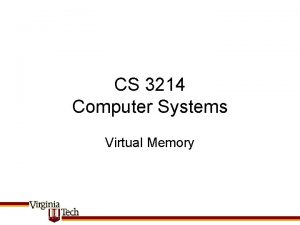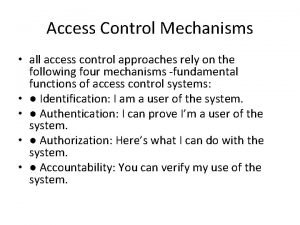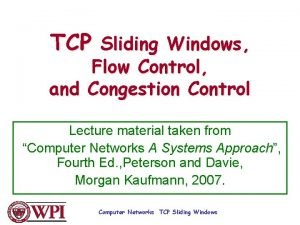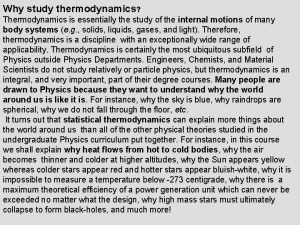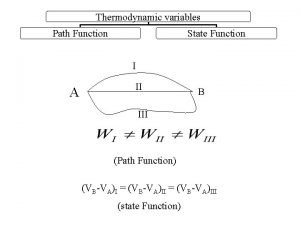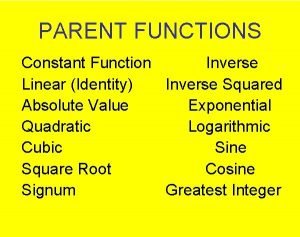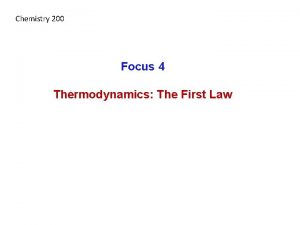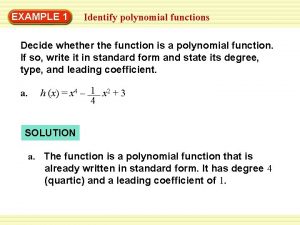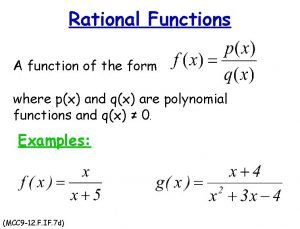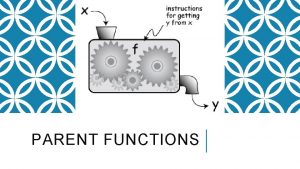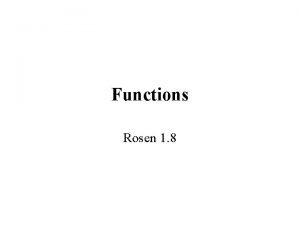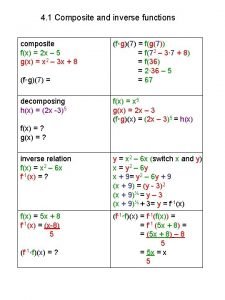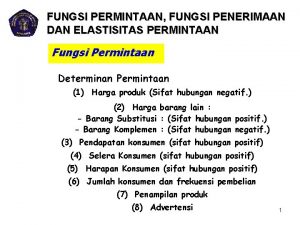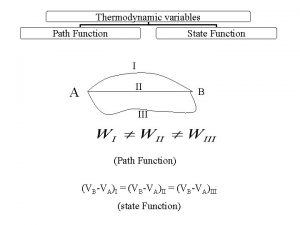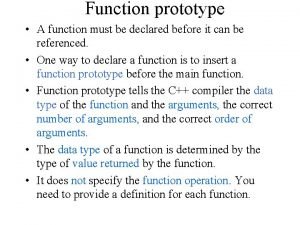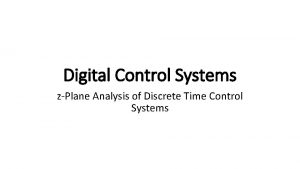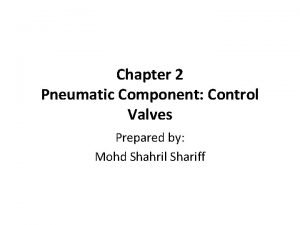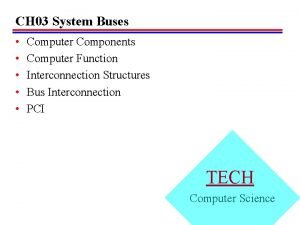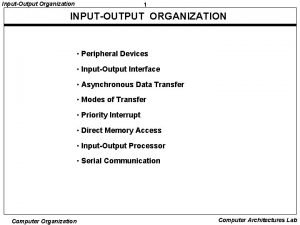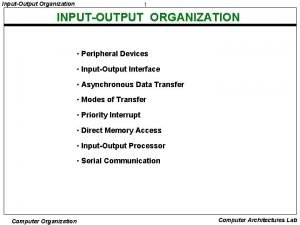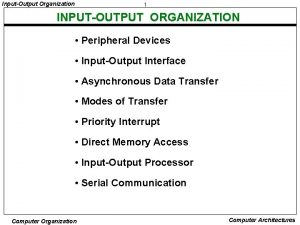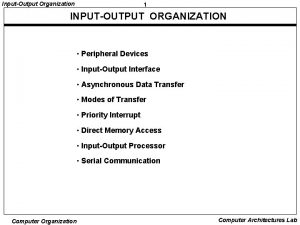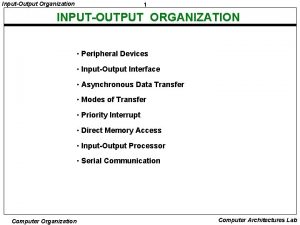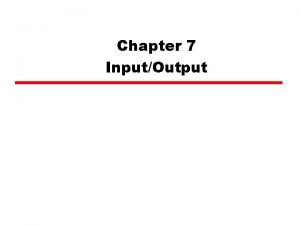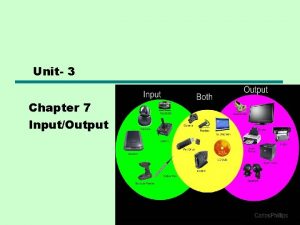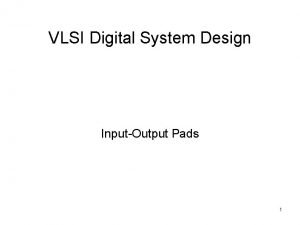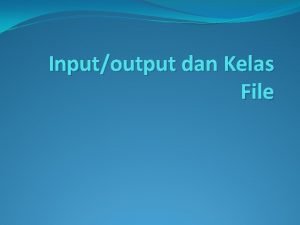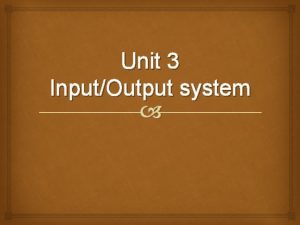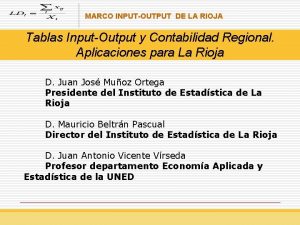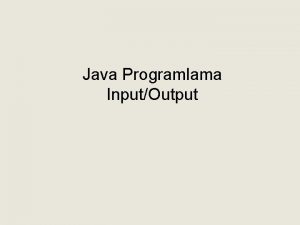InputOutput Control IO Control Mechanism mmap function munmap
















































- Slides: 48

Input/Output Control

목 차 • I/O Control Mechanism – mmap function – munmap function • • RAM Area Access LED Control 4 digits 7 Segment Control Text LCD Control


I/O Control Mechanism (2) • 응용 프로그램에서 특정번지 액세스 – pointer 변수를 이용하여 해당 register의 address에 원하는 데 이터를 write하는 programming – 예제) 물리 주소: 0 xf 100 0000, 데이터: 0 xc 0 unsigned char *ptr; ptr = 0 xf 100 0000 /* register physical address */ *ptr = 0 xc 0 /* write data value to register */ – 오류 발생: Linux kernel 에서 물리적 접근을 허가하지 않음, 가상주소를 사용




mmap() function (2) • Protection mode - PROT_EXEC: page execution PROT_READ: page read 허락 PROT_WRITE: page write 허락 PROT_NONE: page access 불가 • Flag parameters - MAP_FIXED: 특정한 mapping 위치로 고정 - MAP_SHARED: 다른 프로세스와 mapping 영역의 공유가 가 능 - MAP_PRIVATE: mapping을 설정한 자신만의 mapping 영역의 사용이 가능



munmap() usage(1) • munmap() – mmap()과 pair 함수 – Memory mapping을 해제하는 기능 • 형식 – #include <unistd. h> – #include <sys/mman. h> – int munmap (void *start, size_t length); • Argument – Start: mmmap()에서 반환했던 가상주소를 대입 함으로서, 해제할 mapping 영역을 공지 – Length: 해제할 때 영역의 길이를 byte 단위로 계산하여 대입 • munmap() Return value – Success: return (0) – Fail: return (-1)



Example of mmap() (1) #include <stdlib. h> #include <unistd. h> #include <sys/mman. h> #include <asm/fcntl. h> int main() { int men_fd; unsigned long *men_add 32, *ptr; if((mem_fd=open(“/dev/mem”, O_RDWR)) < 0){ perrpr(“mem open failn”); exit(2); } } mem_addr 32=mmap(NULL, 1240, (PRO_READ| PROT_WRITE), MAP_SHARED, mem_fd, 0 xff 00 0000); if((int men_add 32 < 0) { mem_addr 32 = NULL; printf(“mmap errorn”); return -1; }

Example of mmap() (2) wrtie_data () { ptr=mem_addr 32; ptr=ptr+68; *ptr=0 x 1000 0401; ptr++; *ptr=0 xf 100 8000; } release_function() { } mummap(mem_add 32, 1024); return 0;

RAM Area Access Control • RAM Area – SRAM 256 Kbytes × 16 bits, 1 Mbytes – Hardware signal: PXA 255 Chip Selection (CS) n. CS 3 – 0 x 0 c 0000 • Diagram

RAM Area Access Program (1) • RAM(0 x 0 c 00 0000)을 액세스하는 프로그램 코딩(readram) – /dev/mem – mmap( , , , 0 x 0 c 0000000) – mumap() • Boot loader 상에서 0 x 0 c 00 0000 번지의 데이터 확인(read) 및 “ 1234568”을 write – read b 32 0 x 0 c 000000 a – write b 32 0 x 0 c 000000 12345678 1. Linux booting 및 RAM access 프로그램 수행 1. EMPOS # boot 2. #. /readsram 3. sram_val: 12345678

RAM Area Access Program (2) 1. SRAM 하드웨어 번지를 정의 : (prgram name: readram) #define ADDRESSOFSRAM 0 x 0 c 00 0000 2. 가상번지를 저장할 변수를 저장하고, open 함수로 fd 설정 unsigned long *addr_sram; fd=open(“/dev/mem", O_RDWR|O_SYNC)) 3. mmap 함수를 이용하여 SRAM 영역의 가상번지를 획득 addr_sram = mmap(NULL, 1, PROT_READ, MAP_SHARED, fd, ADDRESSOFSRAM); 4. 얻은 번지의 내용을 확인하는 코드 삽입 printf("sram_val: [%x]n", *addr_sram); 5. Makefile을 작성하여 컴파일 CC = arm‐linux‐gcc readsram: readsram. c $(CC) $(CFLAGS) ‐o $@ $^ clean: rm ‐f readsram 6. 확인된 내용이 정확한가를 bootloader에서 재확인 EMPOS # read b 32 0 x 0 c 000000 a 7. 로더에서 SRAM 영역에 값을 넣은 후 다시 한번 확인 EMPOS # write b 32 0 x 0 c 000000 12345678 ; ; bootloader에서 해당번지에 데이터를 입력 EMPOS # boot ; ; linux booting #. /readsram ; ; linux에서 해당 번지의 RAM을 접근 sram_val: 12345678

LED Control (1) • 8개 SMD 형태의 LED로 구성: 8 bit(1 byte) write 구조 • 특정번지(0 x 1060 0000)에서 데이터 bit를 출력으로 LED를 on/off 제어 – – fd=open(“/dev/mem”, O_RDRW|O_SYNC) led_addr=mmap(NULL, 1, PROT_WRITE, MAP_SHARED, fd, 0 x 10600000) led_light{ …. *led_addr =0 xaa, delay-fector() …. } munmp(led_addr, 1); • 회로

LED Control (2) • LED Register: 0 x 1060 0000, 8 bits

7 segment Control (1) • 4개의 7 segment LED로 구성된 write 구조 – 4개의 7 segment는 8개의 출력 bit로 구성 – 32 bit CPU 제어를 위해 2개의 7 segment 단위(16 bits)로 제어 – 7 segment LED 정보 지속을 위해 latch 구조 • 회로 7 segment_low =0 x 1030 0000 7 segment_low =0 x 1040 0000

7 segment Control (2) • BCD-to-7 segment Decoder – Activate signal: positive, negative – Display: 0 -1 figures • Code – 1: 0 bc 0 0000 – 2: ab 0 d e 0 g 0 a f b g e c d dp

7 segment LED Data: Cathode type • Cathode type: active High • Table 7 세그먼트 비트 값 표시 데이터 값 dp g f e d c b a 0 0 0 1 1 1 0 x 3 f 1 0 0 0 1 1 0 0 x 06 2 0 1 1 0 x 5 f 3 0 1 0 0 1 1 0 x 4 f 4 0 1 1 0 0 x 66 5 0 1 1 0 1 0 x 6 d 6 0 1 1 1 0 x 7 d 7 0 0 1 1 1 0 x 27 8 0 1 1 1 1 0 x 7 f 9 0 1 1 1 1 0 x 6 f • Program – char Get. Segcode(char x) { … switch(x) …. . }

7 segment Program (1) • Header file – #define segment 7_L 0 x 10300000 – #define segment 7_H 0 x 10400000 • void Showsegment(unsigned int high. Value, unsigned int low. Value) – – – addr_lseg=mmap(NULL, 4, PROT_WRITE, MAP_SHARED, fd, segment 7_L); addr_hseg=mmap(NULL, 4, PROT_WRITE, MAP_SHARED, fd, segment 7_H); *addr_lseg = low. Value; *addr_hseg = high. Value; munmap(addr_lseg, 4); munmap(addr_hseg, 4); • int sizeofword(char *word) • char Getsegcode(char x){ … switch(x) …. . }

7 segment Program (2) int main() { int k; unsigned int low = 0, high = 0; char data[5]; strcpy(data, "0000"); k = sizeofword(data); switch(k) { case 1: low = Getsegcode(data[0]); break; case 2: low = Getsegcode(data[0]); low = (low<<8) | Getsegcode(data[1]); break; case 3: high = Getsegcode(data[0]); low = Getsegcode(data[1]); low = (low<<8) | Getsegcode(data[2]); break; case 4: high = Getsegcode(data[0]); high = (high<<8) | Getsegcode(data[1]); low = Getsegcode(data[2]); low = (low<<8) | Getsegcode(data[3]); break; default : break; } showsegment(high, low); exit(0); }



Text LCD module • Text LCD – 최대 가로로 쓰여지는 문자 수와 세로로 표시되는 줄 수로 규격 – 열과 행을 구동하는 LCD driver와 이를 제어하는 LCD controller로 구성: Text LCD모듈은 8 bit microprocessor가 내장되어 있고, 2개의 레지스터가 존재 – 20 2(4), 16 2(4), 24 2(4), 14 2(4) size • Signals: 14 pins – Data: byte, DB 0 – DB 7 – Control: R/W, RS (Register Select), E (Enable) – Power: GND (Vss), Vcc, Vo (LCD contrast) Signals (pin) Display (back light)

Text LCD module 제어 방법 • Text LCD Registers – Instruction Register (IR) : Text LCD 모듈의 환경설정 – Data Register (DR) : Text LCD 모듈에 글자를 표시하기 위한 데이터 값이 들어가는 레지스터 • Text LCD를 사용방법 – Instruction Register (IR)에 명령을 set – Data Register (DR)에 표시하고자 하는 데이터 값을 write • Text LCD 모듈 접속회로 설계방법 – Text LCD의 data line은 8 bit, control bit가 3 bit이므로 디바이 스 드라이버에서는 하위 8 bit는 data line으로 묶고, 상위 3 bit 는 control line(R/W, RS, E)으로 사용

Text LCD Functions • 4/8/32 bits microprocessor와 인터페이스 • 디스플레이 dot resolution: 5 8, 5 10 dots • 80 8 bits의 display data RAM: Display Data RAM에 최대 80 문자 저장 가능) • 240 문자 font 를 위한 문자 발 생 기 ROM(Character Generator ROM) • 64 8 bits 문자 발생기 CG RAM • DC 5 volt 단일 전원과 LCD Contrast Control Power LCD segment Driver RS=1 IN/OUT Buffer RS=0 LCD segment Driver Data Register(DR) Instruction Register(IR) Microprocessor Interface RS R/W E D 0 D 7 5 V GND

Text LCD Block Diagram • Block diagram



Text LCD I/F Circuit • Circuit

Register Section • Register 선택: RS, R/W signal 사용 RS R/W action 0 0 - IR 선택, 제어명령 쓰기(display clear, etc) 0 1 - DB 7로부터 Busy Flag를 읽기 - address counter를 DB 0 -DB 6으로 읽기 1 0 - DB 선택하여 데이터 값을 쓰기(DR에서 DD RAM CG RAM으로) 1 1 - DB 선택하여 데이터 값을 읽어오기(DD RAM/ CG RAM에서 DR로)

setcommand • Void secommand (unsigned short command) function b 10=E, b 9=R/W, b 8=RS 0 0 0 xxxx 1 0 0 xxxx 0 0 0 xxxx – RS=0, R/W=0 : IR selection and write instruction data value – E=0 : E=low/E=high/E=low ---> activation


BF, AC, DD RAM (2) • DD RAM address – Text LCD base address: 0 x 1070 0000 – DDRAM address = base address + 1 st/2 nd column address


Text LCD Control Functions(1) • Text LCD 제어 기능 – – – – – Clear display Cursor Return home Entry Mode Set Display ON/OFF Control Cursor Display Shift Function Set: Initialization CG RAM Address Set, DD RAM Address Set Busy Flag/Address Read CG RAM/DD RAM으로 데이터 Write와 Read • 제어 신호: RS, R/W, DB 0 -DB 7, E

Text LCD Control Functions(2) • Control function & Instruction Mode/Code 기 능 제어신호 제어 명령 실행시간 RS R/W D 7 D 6 D 5 D 4 D 3 D 2 D 1 D 0 Clear Display 0 0 0 0 0 1 1. 64 ms Return Home 0 0 0 0 1 0 1. 64 ms Entry Mode Set 0 0 0 0 1 I/D S 40 us Display On/Off control 0 0 0 1 D C S 40 us Cursor or Display Shift 0 0 0 1 S/C R/L 0 0 40 us Function Set 0 0 1 D/L N F 0 0 40 us Set CG RAM Address 0 0 0 1 Set DD RAM Address 0 0 1 DD RAM Address 40 us Read Busy Flag and Address 0 1 BF Address Counter 0 us Data Write to CG RAM or DD RAM 1 0 Write Address 40 us Data Read to CG RAM or DD RAM 1 1 Read Address 40 us CG RAM Address 40 us

Read Timing Diagram • R/W 신호가 인가된 후, E 신호가 activate 된 후에 40 ns 후 에 data line에 valid data 신호가 인가 Active edge

Write Timing Diagram • Write Timing • Code b 10=E, b 9=R/W, b 8=RS 0 0 1 1 0 0 1


Text LCD Program (1) #include <stdlib. h> #include <unistd. h> #include <sys/mman. h> #include <asm/fcntl. h> #include <stdio. h> #define ADDRESSOFTEXTLCD 0 x 10700000 void setcommand(unsigned short command); void initialize_textlcd(); void setcommand(unsigned short command); void writebyte(char ch); void initialize_textlcd(); void write_string(char *str, int length); int function_set(int rows, int nfonts); int display_control(int display_enable, int cursor_enable, int nblink); int cusrsor_shit(int set_screen, int set_rightshit); int entry_mode_set(int increase, int nshift); int return_home(); int clear_display(); int set_ddram_address(int pos); unsigned int *p. Textlcd;

Text LCD Program (2) int main(int argc, char **argv) { int fd; int i, len 1=11, len 2=19; char buf 1[100] = "Wellcome to"; char buf 2[100] = "the Embedded World!"; if(argc == 2) { len 1 = strlen(argv[1]); len 2 = 0; strcpy(buf 1, argv[1]); }else if(argc >= 3) { len 1 = strlen(argv[1]); len 2 = strlen(argv[2]); strcpy(buf 1, argv[1]); strcpy(buf 2, argv[2]); } if ((fd=open("/dev/mem", O_RDWR|O_SYNC)) < 0){ perror("mem open failn"); exit(1); } p. Textlcd=mmap(NULL, 4, PROT_WRITE, MAP_SHARED, fd, ADDRESSOFTEXTLCD); if((int)p. Textlcd < 0){ p. Textlcd=NULL; close(fd); printf("mmap errorn"); return ‐ 1; } initialize_textlcd(); for(i=0; i<len 1; i++) writebyte(buf 1[i]); set_ddram_address(0 x 40); for(i=0; i<len 2; i++) writebyte(buf 2[i]); munmap(p. Textlcd, 4); close(fd); }

Text LCD Program (3) • Initialization • Screen erase • Cursor control

 Inputoutput devices
Inputoutput devices Mmap returns ffff
Mmap returns ffff Centaurilog.mmap
Centaurilog.mmap Mmap vs read
Mmap vs read Functions of steering system
Functions of steering system Concurrency control mechanism
Concurrency control mechanism Access control mechanisms
Access control mechanisms Internal control mechanism
Internal control mechanism What is this picture
What is this picture Sliding window flow control mechanism
Sliding window flow control mechanism Why study thermodynamics
Why study thermodynamics Rational functions parent function
Rational functions parent function Rational graph parent function
Rational graph parent function Pressure is state function or path function
Pressure is state function or path function Constant parent function
Constant parent function Linear and nonlinear tables
Linear and nonlinear tables Exponential parent function graph
Exponential parent function graph Pressure is state function or path function
Pressure is state function or path function 1-6 relations and functions answers
1-6 relations and functions answers What is the parent function of a linear equation
What is the parent function of a linear equation Piecewise functions absolute value
Piecewise functions absolute value Direct substitution polynomial
Direct substitution polynomial Rational function examples
Rational function examples How a predicate function become a propositional function?
How a predicate function become a propositional function? Quadratic cubic linear
Quadratic cubic linear One one function and onto function
One one function and onto function Composite exponential function
Composite exponential function Composite fx
Composite fx Fungsi penerimaan
Fungsi penerimaan Polynomial function parent function
Polynomial function parent function Heat capacity is path function
Heat capacity is path function College algebra polynomials
College algebra polynomials What is function prototype
What is function prototype Webgoat missing function level access control
Webgoat missing function level access control Mechanisms of hypothalamic control over endocrine function
Mechanisms of hypothalamic control over endocrine function Block diagram of digital control system
Block diagram of digital control system 5 uses of control account
5 uses of control account Pneumatic timer symbol
Pneumatic timer symbol Bus interconnection scheme diagram
Bus interconnection scheme diagram The cruise-control function on georgina's car
The cruise-control function on georgina's car Hardwired control unit diagram
Hardwired control unit diagram Primary control vs secondary control
Primary control vs secondary control Distinguish between process control and product control
Distinguish between process control and product control Fluid mechanics
Fluid mechanics Stock control e flow control
Stock control e flow control Control volume vs control surface
Control volume vs control surface Positive vs negative gene regulation
Positive vs negative gene regulation Negative control
Negative control Jelaskan tentang error control pada data link control?
Jelaskan tentang error control pada data link control?

